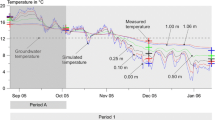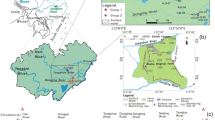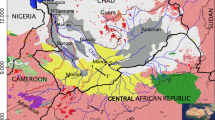Abstract
Surface-water/groundwater exchange impacts water quality and budgets. In karst aquifers, these exchanges also play an important role in dissolution. Five years of river discharge data were analyzed and a transient groundwater flow model was developed to evaluate large-scale temporal and spatial variations of exchange between an 80-km stretch of the Suwannee River in north-central Florida (USA) and the karstic upper Floridan aquifer. The one-layer transient groundwater flow model was calibrated using groundwater levels from 59 monitoring wells, and fluxes were compared to the exchange calculated from discharge data. Both the numerical modeling and the discharge analysis suggest that the Suwannee River loses water under both low- and high-stage conditions. River losses appear greatest at the inside of a large meander, and the former river water may continue across the meander within the aquifer rather than return to the river. In addition, the numerical model calibration reveals that aquifer transmissivity is elevated within this large meander, which is consistent with enhanced dissolution due to river losses. The results show the importance of temporal and spatial variations in head gradients to exchange between streams and karst aquifers and dissolution of the aquifers.
Résumé
L’échange entre les eaux de surface et les eaux souterraines impacte la qualité de l’eau et le bilan hydrique. Dans les aquifères karstiques, ces échanges jouent aussi un rôle important dans la dissolution. Une série temporelle des débits de cours d’eau sur une période de cinq ans a été analysée et un modèle d’écoulement souterrain transitoire a été développé pour évaluer à une grande échelle, les variations temporelles et spatiales des échanges entre un tronçon de 80 km de la rivière Suwannee dans le centre nord de la Floride (Etats-Unis) et l’aquifère karstique du Floridien supérieur. Le modèle hydrogéologique transitoire monocouche a été calibré en utilisant les niveaux piézométriques de 50 piézomètres, et les flux ont été comparés aux échanges calculés à partir des données de débit. Tant la modélisation numérique que l’analyse des débits suggèrent que la rivière Suwannee a des pertes d’eau aussi bien en conditions de basses eaux que de hautes eaux. Les pertes de la rivière apparaissent comme étant les plus importantes à l’intérieur d’un grand méandre, et l’eau de la rivière peut cheminer à travers le méandre en s’infiltrant dans l’aquifère plutôt que de retourner vers la rivière. De plus, la calibration du modèle numérique révèle que la transmissivité de l’aquifère est élevée au sein de ce grand méandre, ce qui est cohérent avec une dissolution accrue due aux pertes de la rivière. Les résultats montrent l’importance des variations spatio-temporelles dans les gradients hydrauliques en faveur des échanges entre les eaux de surface des cours d’eau et les aquifères karstiques et de la dissolution des aquifères.
Resumen
El intercambio agua superficial/agua subterránea afecta la calidad del agua y los balances. En los acuíferos kársticos, estos intercambios también juegan un rol importante en la disolución. Se analizaron cinco años de datos de descarga del río y se desarrolló un modelo de flujo transitorio de agua subterránea para evaluar las variaciones espaciales y temporales a gran escala del intercambio entre un tramo de 80 km del Río Suwannee en el centro norte de Florida (EEUU) y el acuífero kárstico superior de Florida. Se calibró el modelo de flujo transitoria de agua subterránea de una capa usando los niveles de agua subterránea de 59 pozos de monitoreo, y se compararon los flujos con el intercambio calculado de los datos de descarga. Tanto el modelado numérico como el análisis de la descarga sugieren que el rio Suwannee pierde agua en condiciones de niveles altos y bajos. Las pérdidas del río parecen ser mayores en el interior de un gran meandro, y el agua del antiguo río puede continuar a través del meandro dentro del acuífero antes que retornar al río. Además, la calibración del modelo numérico revela que la transmisividad del acuífero es elevada dentro de este gran meandro, lo cual es consistente con la disolución enriquecida debido a las pérdidas del río. Los resultados muestran la importancia de las variaciones espaciales y temporales en los gradientes de la carga hidráulica para el intercambio entre corrientes y acuíferos kársticos y la disolución de los acuíferos.
摘要
地表水/地下水交换影响水质和水平衡计算。在岩溶含水层中,这些交换在岩石溶解中也发挥 着重要作用。分析了5年来的河流排泄资料,建立了瞬时地下水流模型,以评估(美国)佛罗里达州中北部80千米萨旺尼河和上佛罗里达系岩溶含水层之间地表水/地下水交换的 大规模时空变化。采用 59个观测井地下水位资料校正了单层瞬时地下水水流模型,比较了通量与根据排泄资料计算出的交换量。数值模拟和和排泄分析显示,萨旺尼河在水位低和高的情况下,河水流失。河水在大的河曲之内流失最多,先前的河水可在含水层内继续越过河曲,而 不流回河流。另外,数值模型校正揭示,含水层导水系数在这个大的河曲之内升高,与河水流失造成的岩石溶解增强相一致。结果显示了水头坡度时空变化对河流和岩溶含水层之间的交换及含水层岩石溶解的重要性
Resumo
As interações água superficial/subterrânea afetam a qualidade da água e o balanço hídrico. Em aquíferos cársicos poderão desempenhar também um papel importante na dissolução da rocha. Para avaliar as variações temporais e espaciais a grande escala das trocas de água entre um troço de 80 km do Rio Suwannee, no centro-norte da Flórida (EUA), e o aquífero superior cársico da Flórida, foram analisados dados de caudal do rio para um período de cinco anos e foi construído um modelo transitório de escoamento subterrâneo. O modelo de camada única foi calibrado com níveis de água subterrânea de 59 poços de monitorização, e os fluxos foram comparados com as trocas de água calculadas a partir dos dados de caudal. A modelação numérica e a análise dos dados de descarga sugerem ambos que o Rio Suwannee perde água tanto em condições de níveis baixos como com níveis elevados. As perdas do rio parecem maiores no interior de um grande meandro, e as águas que anteriormente pertenciam ao rio poderão atravessar o meandro por dentro do aquífero ao invés de retornar ao rio. Além do mais, a calibração do modelo numérico revela que a transmissividade do aquífero dentro deste grande meandro é elevada, o que é coerente com a dissolução mais elevada devido às perdas do rio. Os resultados mostram a importância das variações temporais e espaciais nos gradientes hidráulicos para as interações entre rios e aquíferos cársicos e para a dissolução das rochas constituintes dos aquíferos.








Similar content being viewed by others
References
Abusaada M, Sauter M (2013) Studying the flow dynamics of a karst aquifer system with an equivalent porous medium model. Ground Water 51(4):641–50. doi:10.1111/j.1745-6584.2012.01003.x
Anderson MP, Woessner WW (1992) Applied groundwater modeling: simulation of flow and advective transport. Academic, San Diego, CA, 381 pp
Brown AL, Martin JB, Screaton EJ, Ezell JE, Spellman P, Gulley J (2014) Bank storage in karst aquifers: the impact of temporary intrusion of river water on carbonate dissolution and trace metal mobility. Chem Geol 385:56–69
Budd DA, Vacher HL (2002) Facies control on matrix permeability in the upper Floridan aquifer, west-central Florida: implications to diffuse flow. Karst Waters Institute Spec Pub 7:14–24
Bush PW, Johnston RH (1988) Ground water hydraulics, regional flow, and ground-water development of the Floridan aquifer system in Florida and in parts of Georgia, South Carolina, and Alabama. US Geol Surv Prof Pap 1403-C
Ceryak R, Herd CD, Jenkins D (2010) Potentiometric surface of the upper Floridan aquifer in the Suwannee River Water Management District September 2009. http://www.srwmd.state.fl.us/DocumentCenter/Home/View/2147. Accessed 15 Jan 2014
Cook PG (2013) Estimating groundwater discharge to rivers from river chemistry surveys. Hydrol Process 27:3694–3707. doi:10.1002/hyp.9493
Crandall CA, Katz BG, Hirten JJ (1999) Hydrochemical evidence for mixing of river water and groundwater during high-flow conditions, lower Suwannee River basin, Florida, USA. Hydrogeol J 7(5):454–467
Doherty JE, Hunt RJ (2010) Approaches to highly parameterized inversion: a guide to using PEST for groundwater-model calibration. US Geol Surv Sci Invest Rep 2010–5169, 59 pp
Fetter CW (2001) Applied hydrogeology. Prentice-Hall, Upper Saddle River, NJ, 59 pp
Florea LJ, Vacher HL (2007) Eogenetic karst hydrology: insights from the 2004 hurricanes, peninsular Florida. Ground Water 45(4):439–446
Ghasemizadeh R, Hellweger F, Butscher C, Padilla I, Vesper D, Field M (2012) Review: Groundwater flow and transport modeling of karst aquifers, with particular reference to the North Coast Limestone aquifer system of Puerto Rico. Hydrogeol J 20(8):1441–1461
Grubbs JW (1998) Recharge rates to the Upper Floridan Aquifer in the Suwannee River Water Management District, Florida. University of Michigan Library, Lansing MI, 36 pp
Grubbs JW, Crandall CA (2007) Exchanges of water between the Upper Floridan Aquifer and the Lower Suwannee and Lower Santa Fe rivers, Florida. US Geol Surv Prof Pap 1656-C, 93 pp
Gulley J, Martin JB, Screaton EJ, Moore PJ (2011) River reversals into karst springs: a model for cave enlargement in eogenetic karst aquifers. Geol Soc Am Bull 123:457–467
Gulley J, Martin J, Spellman P, Moore P, Screaton E (2013) Dissolution in a variably confined carbonate platform: effects of allogenic runoff, hydraulic damming of groundwater inputs, and surface-groundwater exchange at the basin scale. Earth Surf Proc Land 38:1700–1713
Hirsch RM, Costa JE (2004) US stream flow measurement and data dissemination improve. EOS Trans Am Geophys Union 85(21 ):197–203
Kalbus E, Reinstorf F, Schirmer M (2006) Measuring methods for groundwater–surface water interactions: a review. Hydrol Earth Syst Sci 10(6):873–887
Katz BG (2004) Sources of nitrate contamination and age of water in large karstic springs of Florida. Env Geol 46:689–706. doi:10.1007/s00254-004-1061-9
Katz BG, Coplen TB, Bullen TD, Davis JH (1997a) Use of chemical and isotopic tracers and geochemical modeling to characterize the interactions between ground water and surface water in mantled karst. Ground Water 35(6):1014–1028
Katz BG, DeHan RS, Hirten JJ, Catches JS (1997b) Interactions between ground water and surface water in the Suwannee River basin, Florida. J Am Water Res Assoc 33:1237–1254. doi:10.1111/j.1752-1688.1997.tb03549.x
Khadka MB, Martin JB, Jin J (2014) Transport of dissolved carbon and CO2 degassing from a river system in a mixed silicate and carbonate catchment. J Hydrol 513:391–402. doi:10.1016/j.jhydrol.2014.03.070
Loheide SP, Gorelick SM (2006) Quantifying stream-aquifer interactions through analysis of remotely sensed thermographic profiles and in-situ temperature histories. Environ Sci Tech 40:3336–3341
Marella R (2014) Water withdrawals, use, and trends in Florida, 2010. US Geol Surv Sci Invest Rep 2014-5088, 59 pp
Martin JB, Gordon SL (2000) Surface and ground water mixing, flow paths, and temporal variations in chemical compositions of karst springs. In: Sasowsky I, Wicks CM (eds) Groundwater flow and contaminant transport in carbonate aquifers. Balkema, Rotterdam, The Netherlands, pp 65–92
McDonald MG, Harbaugh AW (1984) A modular three-dimensional finite-difference ground-water flow model. US Geol Surv Open File Rep 83-875
Meyer B, Kincaid T, Hazlett T (2008) Modeling karstic controls on watershed-scale groundwater flow in the Floridan aquifer of North Florida. In: Yuhr LB, Alexander Jr C, Beck B (eds) Sinkholes and the engineering and environmental impacts of karst. ASCE, Washington, DC, pp 351–361.doi: 10.1061/41003(327)33
Mitchell MW (2004) Evaluation of the agricultural field scale irrigation requirement simulation (AFSIRS) in predicting golf course irrigation requirements with site-specific data. University of Florida, Gainesville, FL, 51 pp
Moore PJ, Martin JB, Screaton EJ, Neuhoff PS (2010) Conduit enlargement in an eogenetic karst aquifer. J Hydrol. doi:10.1016/j.jhydrol.2010.08.008
Mossa J, Konwinski J (1998) Thalweg variability at bridges along a large karst river: the Suwannee River, Florida. Eng Geol 49:15–30
Opsahl SP, Chapal SE, Hicks DW, Wheeler CK (2007) Evaluation of ground-water and surface-water exchanges using streamflow difference analyses. J Am Water Res Assoc 43:1132–1141. doi:10.1111/j.1752-1688.2007.00093.x
Palmer AN (2002) Karst in Paleozoic rocks: how does it differ from Florida? Karst Waters Inst Spec Pub 7:185–190
Planert M (2007) Simulation of regional ground-water flow in the Suwannee River Basin, northern Florida and southern Georgia. 2007-5031, 50 pp
Ritorto M, Screaton EJ, Martin JB, Moore PJ (2009) Relative importance and chemical effects of diffuse and focused recharge in an eogenetic karst aquifer: an example from the unconfined upper Floridan aquifer, USA. Hydrogeol J 17:1687–1698
Scanlon BR, Mace RE, Barrett ME, Smith B (2003) Can we simulate regional groundwater flow in a karst system using equivalent porous media models? Case study, Barton Springs Edwards aquifer, United States of America. J Hydrol 276:137–158
Schneider JW, Upchurch SB, Chen J, Cain C (2008) Simulation of groundwater flow in north Florida and south-central Georgia. Suwannee River Water Management District, Live Oak, FL, 92 pp
Sepulveda N (2002) Simulation of ground-water flow in the Intermediate and Floridan aquifer systems in Peninsular Florida. US Geol Surv Water Resour Invest Rep 02-4009
Suwannee River Water Management District (2010) Water supply assessment. Suwannee River Water Management District, Live Oak, FL. http://www.srwmd.state.fl.us/DocumentCenter/Home/View/1759. Accessed 15 Jan 2014
University of Florida IFAS Extension (2014) Florida automated weather network. http://fawn.ifas.ufl.edu/. Accessed 15 Jan 2014
Upchurch SB (2002) Hydrogeochemistry of a karst escarpment. In: Martin JB, Wicks CM, SasowskyI D (eds) Hydrogeology and biology of post-Paleozoic carbonate aquifers. Karst Waters Institute Spec Pub 7, pp 73–75
Vacher HL, Mylroie JE (2002) Eogenetic karst from the perspective of an equivalent porous medium. Carbonates Evaporites 17:182–196
Vogt T, Schneider P, Hahn-Woernle L, Cirpka OA (2010) Estimation of seepage rates in a losing stream by means of fiber-optic high-resolution vertical temperature profiling. J Hydrol 380:154–164
Voss CI (2011) Editor’s message: Groundwater modeling fantasies—part 2, down to earth. Hydrogeol J 19(8):1455–1458
Westhoff MC, Gooseff MN, Bogaard TA, Savenije HHG (2011) Quantifying hyporheic exchange at high spatial resolution using natural temperature variations along a first-order stream. Water Resour Res 47:1–13
Winter TC (1995) Recent advances in understanding the interaction of groundwater and surface water. Rev Geophys 33(S2):985–994. doi:10.1029/95RG00115
Wondzell SM, LaNier J, Haggerty R (2009) Evaluation of alternative groundwater flow models for simulating hyporheic exchange in a small mountain stream. J Hydrol 364:142–151
Acknowledgements
This research was funded by National Science Foundation grant EAR 09107941. The authors thank the Suwannee River Water Management District for providing LiDAR and other data and Environmental Simulations for academic licensing of Groundwater Vistas.
Author information
Authors and Affiliations
Corresponding author
Rights and permissions
About this article
Cite this article
Sutton, J.E., Screaton, E.J. & Martin, J.B. Insights on surface-water/groundwater exchange in the upper Floridan aquifer, north-central Florida (USA), from streamflow data and numerical modeling. Hydrogeol J 23, 305–317 (2015). https://doi.org/10.1007/s10040-014-1213-2
Received:
Accepted:
Published:
Issue Date:
DOI: https://doi.org/10.1007/s10040-014-1213-2




